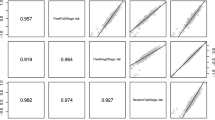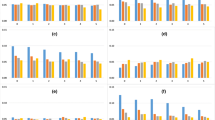Summary
As the sequel to a paper that dealt with the theoretical aspects of linear and bilinear models for the analysis of genotype by environment interaction in multi-environment trials, this paper presents an illustration of the application of these models to real life data. The data come from maize trials that were conducted within the ongoing evaluation programme for the Dutch Descriptive Variety List of Field Crops. The variable that is analyzed is dry matter content. It is shown how linear and bilinear models can be used supplementary to each other within a general strategy for dealing with genotype by environment interaction.
Similar content being viewed by others
References
Decoux, G. & J.B. Denis, 1991. INTERA. Logiciels pour l'interpretation statistique de l'interaction entre deux facteurs. Biometrie INRA Route de Saint Cyr F78026, Versailles, France.
Denis, J.B., 1991. Ajustement de modèles linéaires et bilinéaires sous contraintes linéaires avec données manquantes. Rev. Stat. Appl. XXXIX: 5–24.
Denis, J.B. & C.P. Baril, 1992. Sophisticated models with numerous missing values: The multiplicative interaction model as an example. Biuletyn Oceny Odmian 24–25: 33–45.
Freeman, G.H., 1975. Analysis of interactions in incomplete two-way tables. Appl. Stat. 24: 46–55.
Gabriel, K.R. & S. Zamir, 1979. Lower rank approximations of matrices by least squares with any choice of weights. Technometrics 21: 489–498.
Gauch, H.G., 1990. MATMODEL version 2.0: AMMI and related analyses for two-way data matrices. Microcomputer Power, Ithaca, New York.
Gauch, H.G. & R.W. Zobel, 1990. Imputing missing yield trial data. Theor. Appl. Genet. 79: 753–761.
GENSTAT 5 Committee, 1993. GENSTAT 5 release 3 reference manual. Clarendon Press, Oxford.
Kroonenberg, P.M., K.E. Basford & A.G.M. Ebskamp. 1995. Three-way cluster and component analysis of maize variety trials. Euphytica: this issue.
Lewi, P.J., 1993. SPECTRAMAP V2: Introduction to multivariate analysis of rectangular data tables with emphasis on biplots. Janssen Pharmaceutica, Beersse, Belgium.
Montgomery, D.C. & E.A. Peck, 1982. Introduction to linear regression analysis. Wiley, New York.
Patterson, H.D., 1978. Routine least squares estimation of variety means in incomplete tables. J. Nat. Inst. Agric. Bot. 14: 401–412.
Patterson, H.D. & F. Nabugoomu, 1992. REML and the analysis of series of crop variety trials. In: Proceedings of the XVI-th International Biometric Conference, Vol. 1, pp. 77–93. Hamilton, New Zenland, 7–11 December, 1992.
van Eeuwjjk, F.A., 1995a. Linear and bilinear models for the analysis of multi-environment trials: I. An inventory of models. Euphytica: this issue.
van Eeuwijk, F.A., 1995b. Multiplicative interaction in generalized linear models. Biometrics: in press.
Wricke, G., 1962. Uber eine Methode zur Erfassung der ökologischen Streubreite in Feldversuchen. Z. Pflanzenzüchtg. 47: 92–96.
Author information
Authors and Affiliations
Rights and permissions
About this article
Cite this article
van Eeuwijk, F.A., Keizer, L.C.P. & Bakker, J.J. Linear and bilinear models for the analysis of multi-environment trials: II. An application to data from the Dutch Maize Variety Trials. Euphytica 84, 9–22 (1995). https://doi.org/10.1007/BF01677552
Received:
Accepted:
Issue Date:
DOI: https://doi.org/10.1007/BF01677552




